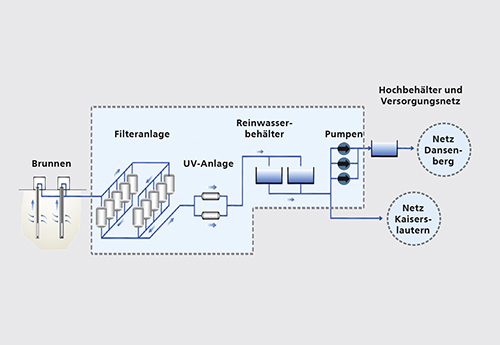The municipal electricity expenditures for the supply of drinking water represent a significant investment. It is assumed that a proper use of pumps based on the information about the drinking water consumption could reduce running costs and thus imply savings in the double-digit percentage range. In cooperation with the faculty of mechanical engineering SAM at the University of Kaiserslautern and in direct contact with water supply companies SWK and EWR and the consultancy Obermeyer, it is the goal of ITWM to exploit these untapped savings potentials in the project H2Opt which is financially supported by the Federal Ministry of Education and Research (BMBF).
Energy Efficiency in the Water Supply Management
Project H₂Opt
Fraunhofer ITWM Develops Supporting Software
The role of the optimization department is to develop a software prototype that assists the water supply companies to design and operate their facilities in a more cost-efficient way. The workflow of the software is divided into three parts:
- In the first part, the planner assembles a customisable model of the water network that takes into consideration the laws of fluid mechanics. The configuration is adaptive and interactive.
- Then, the planner creates a consumption profile corresponding to the day in question. This process depends on additional information such as being a working day, a school day or a holyday as well as humidity, the time of the year or social events.
- Finally, desirable solutions are displayed and the planner is assisted to find the one solution that fits his needs.

Machine Learning Method Develops Intelligent Characteristics
The core idea to increase energy efficiency lies in the consistent use of characteristic curves of the water network and the pumps. The characteristic curves of the water network assign flow rates to the corresponding delivery heads, which represent the water pressure inside the network. Both flow rate and delivery head define the operating state of a pump. Each operating state is as efficient as a pump allows it to be. Ideally, a pump is chosen with efficiency at its maximum.
Databases consisting of typical consumption profiles and pumps available on the market can be used to generate a variety of solutions, which gives the planner an overview of appropriate and inappropriate pump choices. Furthermore, the pump schedules can be used as degrees of freedom. These are displayed in the software on hourly basis taking into account the availability and the size of supply containers. In a first application with our project partners at Worms, pump schedules could be improved with significant energy savings. One of our next steps is to assist SWK at the selection of new pumps for Brunnengebiet Ost.
Project Partners
- Rheinland-Pfälzische Technische Universität Kaiserslautern-Landau (RPTU), Institute of Fluid Mechanics and Fluid Machinery
- EWR Netz GmbH
- OBERMEYER: Planen + Beraten GmbH
- SWK Stadtwerke Kaiserslautern
Funding
The project is funded by the Federal Ministry of Education and Research (BMBF) in the framework programme Research for Sustainable Development (FONA).
